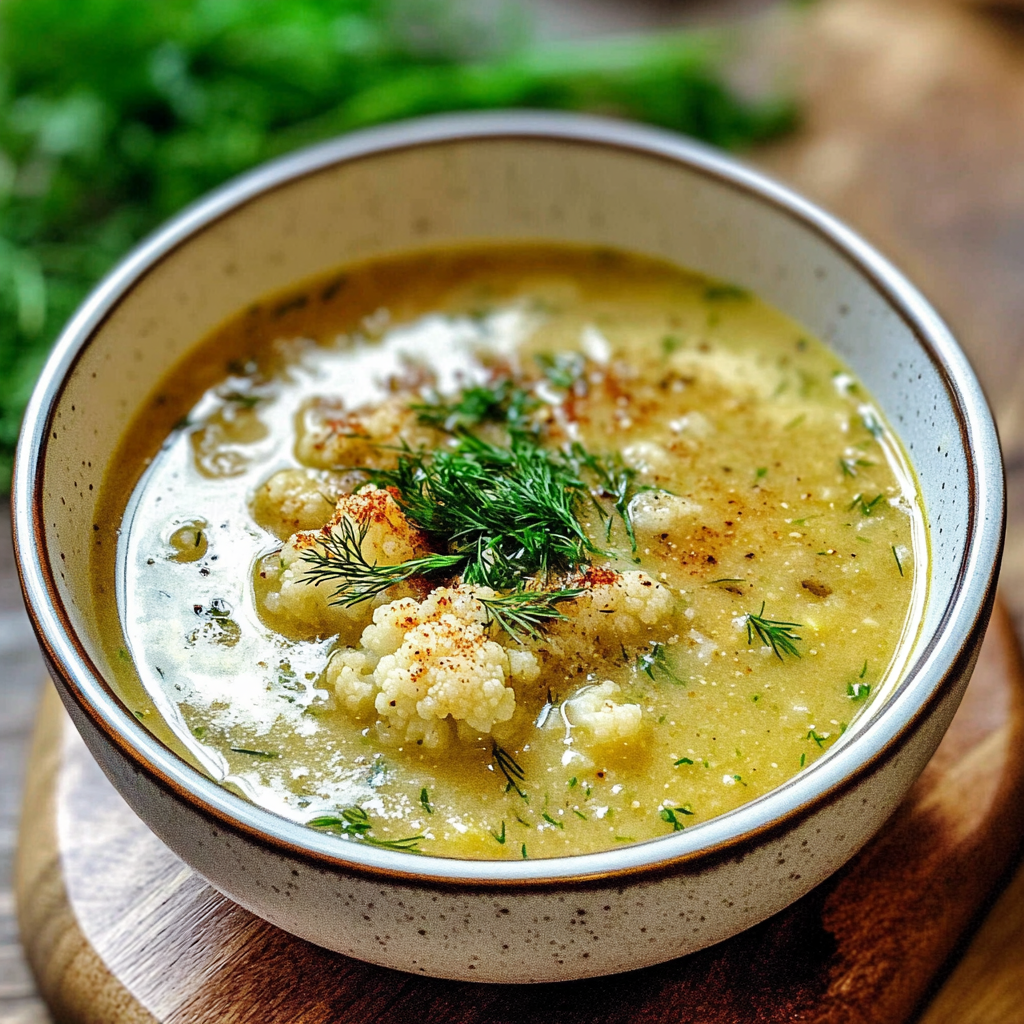This Roasted Cauliflower Soup is a delightful blend of earthy cauliflower and bold Mediterranean spices. The roasting process caramelizes the cauliflower, enhancing its natural sweetness and depth of flavor. The addition of cumin, paprika, turmeric, and sumac infuses the soup with warmth and complexity, while the whole milk provides a creamy texture without being overly rich.
The fresh dill added at the end brings a burst of brightness, balancing the hearty flavors. Served hot, this soup offers a comforting and satisfying meal that’s perfect for cooler evenings. Whether enjoyed as a starter or a main course, it’s a nourishing dish that showcases the versatility of cauliflower in Mediterranean cuisine.
Full Recipe
Ingredients:
-
2 medium heads cauliflower, cut into florets
-
2 tablespoons extra virgin olive oil
-
Salt and black pepper, to taste
-
1 large yellow onion, chopped
-
5 cloves garlic, minced
-
2 teaspoons ground cumin
-
2½ teaspoons sweet paprika
-
1 teaspoon ground turmeric
-
2 teaspoons ground sumac (or lemon zest)
-
4 cups low-sodium vegetable broth
-
1 cup water
-
2 cups whole milk (or unsweetened plant-based milk)
-
Juice of ½ lemon
-
1 cup fresh dill, chopped (or substitute with chives or parsley)
Directions:
-
Preheat oven to 425°F (220°C). Arrange cauliflower florets on a large baking sheet, drizzle with olive oil, and season with salt and pepper. Roast for 40–45 minutes, turning halfway, until deeply browned and tender.
-
While cauliflower roasts, heat 2 tablespoons olive oil in a large pot over medium heat. Add chopped onion and cook until translucent, about 7 minutes. Add minced garlic, cumin, paprika, turmeric, and sumac; sauté until fragrant, about 1 minute.
-
Add ¾ of the roasted cauliflower to the pot, stirring to coat with spices. Pour in vegetable broth and water; bring to a boil. Reduce heat and simmer uncovered for 5–7 minutes.
-
Using an immersion blender, puree the soup until smooth or to desired consistency. Alternatively, transfer in batches to a blender.
-
Stir in whole milk, lemon juice, and remaining roasted cauliflower. Heat through, adjust seasoning with salt and pepper.
-
Remove from heat and stir in fresh dill. Serve hot, garnished with additional dill if desired.
Prep Time: 15 minutes
Cooking Time: 55 minutes
Total Time: 1 hour 10 minutes
Kcal: Approximately 160 kcal per serving
Servings: 6
Introduction to Roasted Cauliflower Soup
Roasted Cauliflower Soup is a simple yet elevated dish that highlights the humble cauliflower in its most flavorful form. Roasting brings out the natural sweetness of cauliflower, and when blended into a creamy base, it creates a smooth, velvety texture that feels indulgent while being remarkably healthy. This soup recipe is especially popular among fans of the Mediterranean diet, offering a combination of nutritious ingredients, earthy spices, and fresh herbs. Its layered flavor profile, enhanced by warm spices like cumin, turmeric, and paprika, adds complexity without overwhelming the palate.
What makes this soup truly stand out is its versatility. It can be served as a light starter or a hearty main course, depending on the portion size and accompaniments. You can enjoy it on its own or pair it with crusty bread, a light salad, or even grilled protein. Best of all, this recipe can be easily adapted to suit various dietary needs—whether vegetarian, vegan, gluten-free, or dairy-free.
The Nutritional Power of Cauliflower
Cauliflower is an incredibly nutrient-dense vegetable that belongs to the cruciferous family, along with broccoli, cabbage, and Brussels sprouts. It’s rich in vitamins C and K, high in fiber, and low in calories, making it a go-to choice for health-conscious cooks. It also contains antioxidants and phytonutrients that can help fight inflammation and reduce the risk of chronic disease.
When roasted, cauliflower undergoes the Maillard reaction—a browning process that caramelizes the natural sugars in the vegetable. This brings out a rich, slightly nutty flavor that forms the backbone of this soup. Unlike boiling or steaming, roasting concentrates the taste and texture, making it a perfect candidate for a rich, creamy soup without the need for heavy cream.
The Role of Mediterranean Spices
One of the defining characteristics of this soup is its infusion of Mediterranean spices. Cumin adds a deep, earthy note with subtle hints of citrus and bitterness. Turmeric brings warmth and a golden hue, while paprika offers a mild sweetness and smokiness. These spices don’t just contribute flavor—they also come with their own range of health benefits.
Cumin is known for its digestive properties and rich iron content. Turmeric contains curcumin, a compound renowned for its anti-inflammatory and antioxidant properties. Paprika, especially the sweet variety used in this recipe, adds vibrant color while boosting vitamin A levels. The spices work in harmony to create a cozy, aromatic experience with every spoonful.
Sumac: A Citrusy Mediterranean Secret
Sumac is an often-overlooked spice in Western kitchens, but it’s a staple in Mediterranean and Middle Eastern cuisine. Made from dried and ground berries, sumac has a tart, lemony flavor that brightens up dishes. In this soup, it complements the richness of the roasted cauliflower and the creaminess of the milk by adding a tangy contrast.
If you don’t have sumac on hand, a small amount of fresh lemon zest or juice can mimic its effect. However, using the authentic spice lends a more complex acidity that enhances the dish’s overall balance.
Fresh Herbs for Brightness and Balance
This recipe calls for a generous amount of fresh dill, which brings a grassy, anise-like freshness to the final product. Dill is a classic Mediterranean herb that lightens up heavier dishes and adds a pop of green color. It’s especially effective in creamy recipes, where it cuts through the richness and keeps the palate refreshed.
If dill isn’t your favorite or isn’t available, other herbs such as fresh parsley, chives, or cilantro can be used. Each herb brings its own character to the soup, allowing you to tailor the flavor to your liking.
Health Benefits of the Soup
Roasted Cauliflower Soup isn’t just comforting—it’s nourishing on multiple levels. The soup is low in calories yet high in fiber and vitamins, helping support digestion and boost your immune system. It’s also an excellent choice for meal-prepping, as it stores well in the fridge and freezes beautifully. The use of vegetable broth keeps it vegetarian, and you can make it vegan by simply swapping the dairy milk for a plant-based option like almond, oat, or coconut milk.
Because the soup is blended, it’s also easy on the digestive system, making it an ideal choice for those recovering from illness or looking for something light yet fulfilling.
How to Customize This Recipe
One of the best things about this soup is how easily it adapts to your preferences or pantry stock. Want it spicier? Add a pinch of chili flakes or cayenne pepper. Prefer a richer texture? Stir in a bit of coconut cream or cashew milk. Want more protein? Top it with chickpeas or pair it with grilled chicken or tofu.
You can also make it chunkier by setting aside a portion of the roasted cauliflower and stirring it back into the soup after blending. For a nutty twist, try adding a spoonful of tahini or a sprinkle of toasted almonds on top.
Ideal Occasions for Serving
This soup is ideal for many occasions—from weeknight dinners to elegant dinner parties. It makes a stunning first course when garnished with fresh herbs and served in shallow bowls, or it can be ladled into mugs for a cozy lunch option. It’s a popular choice during cooler months, but thanks to its light texture and bright flavor, it’s also enjoyable year-round.
If you’re entertaining, consider setting up a soup bar with various toppings: roasted seeds, croutons, yogurt drizzle, chili oil, or fresh herbs. This adds a fun, interactive element for guests while keeping things simple in the kitchen.
Storage and Reheating Tips
Roasted Cauliflower Soup keeps well in the refrigerator for up to five days in an airtight container. The flavors actually deepen over time, making it even tastier the next day. For longer storage, it can be frozen for up to three months. Just make sure to let it cool completely before transferring to freezer-safe containers.
When reheating, do so gently over medium heat. If the soup thickens too much in the fridge, simply add a splash of broth or milk to bring it back to your desired consistency. Avoid boiling the soup when reheating, especially if it contains dairy or plant-based milk, as it may separate or curdle.
Why This Recipe Belongs in Every Home Cook’s Collection
This Roasted Cauliflower Soup exemplifies everything a great homemade dish should be: simple, flexible, nourishing, and delicious. It uses everyday ingredients and basic cooking techniques, yet the result feels like something special. The combination of roasted vegetables, aromatic spices, and fresh herbs makes it more than just a soup—it becomes an experience.
Even if you’re not following the Mediterranean diet, this dish fits seamlessly into a balanced eating plan. It’s vegetarian-friendly, with vegan and gluten-free options, making it a crowd-pleaser for a variety of dietary needs. Whether you’re cooking for yourself, your family, or guests, this soup delivers comfort in a bowl without compromising on flavor or nutrition.
Conclusion
Roasted Cauliflower Soup is proof that simple ingredients can come together to create something truly memorable. With its roots in Mediterranean cuisine, it brings together the best of health and flavor. Roasting the cauliflower intensifies its natural richness, while warm spices and fresh herbs elevate the taste to gourmet levels. Whether you’re trying to eat cleaner, cook more at home, or just enjoy a satisfying bowl of soup, this recipe is one to bookmark and return to again and again.
It’s more than just a soup—it’s a celebration of how plant-based ingredients and traditional cooking techniques can create warmth, comfort, and nourishment. Add it to your culinary rotation and let it become a staple in your kitchen.






